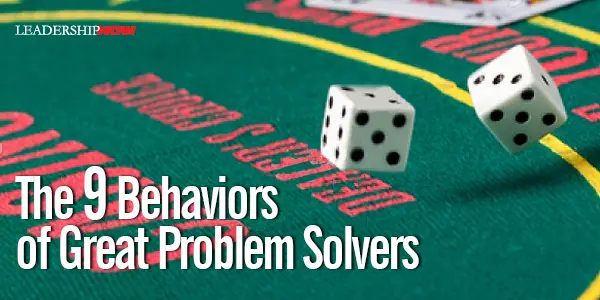 |
 |
04.07.17

The 9 Behaviors of Great Problem Solvers
E Naturally we like simple solutions. But a simple guess is not the same thing as a simple solution. A simple solution is easy to implement. But a simple guess that doesn’t get to the real issues is difficult, expensive, and wasteful to implement. We need to stop guessing. “Every unsolved problem is bottlenecked by not understanding the root cause at a fundamental level.” In Stop Guessing, Nat Greene explains 9 behaviors that great problem-solvers use to solve hard problems. Here are his behavior summaries: 1. Stop Guessing It’s natural for us to guess. The first thing you must do to start solving problems or keep from making them worse is to stop guessing. 2. Smell the Problem Get out and walk around using your natural senses and tools available to you to develop a strong pattern of failure. Ask relevant, thought-provoking questions about the specific problem to guide you to collect information and look for very specific patterns, rather than shotgunning and looking at everything in the system. 3. Embrace You Ignorance It’s what you don’t know that lies between you and the solution. Great problem-solvers not only admit their ignorance but also embrace it and ask questions others might find “stupid,” to shatter old assumptions about the problem. 4. Know What Problem you’re Solving Often, people work on the wrong problem entirely by making some implicit assumption about what’s causing it. Great problem-solvers invest time upfront to make sure the problem they’re working on is well defined, measureable as a variable, and represents precisely what is wrong with the system or process. 5. Dig into the Fundamentals This means learning how the process works, both by understanding the process itself and by understanding some of the fundamental science behind it. By focusing on what controls a problem, you’ll be able to limit your digging to the parts of the process and the science that are relevant, rather than trying to wrap your arms around the entire thing at once. 6. Don’t Rely on Experts Utilizing subject-matter experts is crucial to understanding a complex system and its underlying functionality and science. Unfortunately, most people delegate responsibility for solving the problem to those subject-matter experts, rather than driving the problem-solving process themselves. Great problem-solvers always view experts as collaborators rather than saviors. 7. Believe in a Simple Solution When confronting complex problems, it can be comforting to believe that the solution will be complex as well. But by not believing in a simple solution, people often give up long before they’ve gone through the rigor required to find the simple solution that lies at the root cause, to great cost and detriment. Great problem-solvers will have the belief and tenacity to keep solving until they’ve found the root cause. 8. Make Fact-Based Decisions Avoid making opinion-based decisions: anything that relies on a vote, on authority, or on some subjective ranking system of what decision to make is one of these opinion-based decisions, and it leads problem-solvers astray. 9. Stay on Target When problem-solvers dive deep into a problem, they too frequently seek to expand the number of possible root causes, so they can test them. Great problem-solvers measure the drivers that most immediately control the problem in order to determine whether those subvariables are in control, and in doing so are able to quickly eliminate most possible root causes and avenues of inquiry without having to dive deeper into them. Greene digs deeper in to each of these in separate chapters. Strong problem-solving methods will discourage guessing, provide lots of structure to develop a pattern of failure, and guide you to understand how the process works. Begin problem solving and not solution-guessing. 
Posted by Michael McKinney at 10:59 AM
|
BUILD YOUR KNOWLEDGE
 

How to Do Your Start-Up Right STRAIGHT TALK FOR START-UPS 
Grow Your Leadership Skills NEW AND UPCOMING LEADERSHIP BOOKS 
Leadership Minute BITE-SIZE CONCEPTS YOU CAN CHEW ON 
Classic Leadership Books BOOKS TO READ BEFORE YOU LEAD |